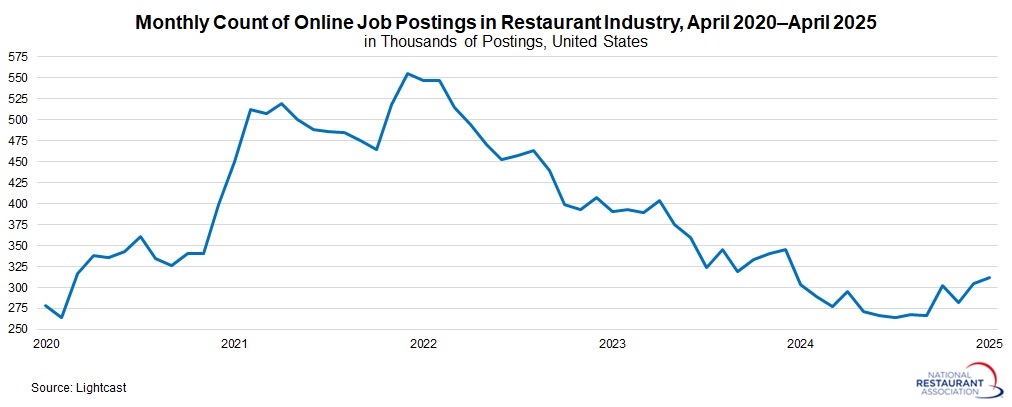Research
May 19, 2025
New Association Website Spotlights Restaurant Jobs and Career Paths
With hundreds of job categories and countless career pathways, the restaurant industry is built on hospitality and creating a sense of belonging. Come see how your passions might fit into a dynamic, people-centered career. To help you get started, the National Restaurant Association Educational Foundation has launched RestaurantsWork— an interactive resource offering data-driven insights on occupational options, possible career paths, and industry trend, both nationally and for specific regions.
For those curious about the industry, it provides a helpful starting point, with information on local employment opportunities, average salaries, and regional trends. And for those thinking strategically about their future, RestaurantsWork highlights how entry-level roles can lead to long-term growth and advancement.
Powered by data from Lightcast, RestaurantsWork draws on a wide range of online job postings to deliver insights into economic, labor market, education, and occupational trends. This robust dataset provides a detailed view of job demand at the national, state, and regional levels—complementing official government data and helping users better understand where opportunities exist and how the market is evolving.
From an economist’s perspective, the Lightcast data serve as a valuable supplement to traditional labor market indicators, offering additional insight into job posting trends in the restaurant industry over time—as illustrated in the accompanying graphic. While the methodology differs from the Bureau of Labor Statistics’ Job Openings and Labor Turnover Survey (JOLTS), both data sources generally reflect similar directional trends. Notably, the number of restaurant job postings has moderated in recent years yet remains relatively stable and strong—underscoring continued demand for talent across the sector.

The RestaurantsWork resource offers two key avenues for exploration. Under the Career Pathways tab, users can dive into one of 50 occupations to learn more about potential roles in the industry. For example, selecting “sous chef” reveals current job openings nationwide, salary ranges, and the states with the highest demand. It also outlines common entry-level roles that can lead to that position and suggests advanced career steps, such as becoming an executive chef. Information on credentialing and training opportunities is also included, helping users map out their path from the entry-level first job to a long-term career.
To explore opportunities in a specific area, users can turn to the Jobs by Geography tab. This feature allows individuals to search by state, county, or metropolitan area, offering localized data on employment levels, salary ranges, and in-demand occupations. Users can also view the most frequently posted job titles in a region and see how demand breaks down by experience level—making it a powerful tool for anyone assessing their local job market or planning their next career move.
In short, RestaurantsWork is a data-driven roadmap for building a career in the restaurant and foodservice industry. Whether you’re just starting out or planning your next step, this resource helps connect your ambitions with real-world opportunities, offering the insights needed to make informed, strategic career decisions.
For those curious about the industry, it provides a helpful starting point, with information on local employment opportunities, average salaries, and regional trends. And for those thinking strategically about their future, RestaurantsWork highlights how entry-level roles can lead to long-term growth and advancement.
Powered by data from Lightcast, RestaurantsWork draws on a wide range of online job postings to deliver insights into economic, labor market, education, and occupational trends. This robust dataset provides a detailed view of job demand at the national, state, and regional levels—complementing official government data and helping users better understand where opportunities exist and how the market is evolving.
From an economist’s perspective, the Lightcast data serve as a valuable supplement to traditional labor market indicators, offering additional insight into job posting trends in the restaurant industry over time—as illustrated in the accompanying graphic. While the methodology differs from the Bureau of Labor Statistics’ Job Openings and Labor Turnover Survey (JOLTS), both data sources generally reflect similar directional trends. Notably, the number of restaurant job postings has moderated in recent years yet remains relatively stable and strong—underscoring continued demand for talent across the sector.

The RestaurantsWork resource offers two key avenues for exploration. Under the Career Pathways tab, users can dive into one of 50 occupations to learn more about potential roles in the industry. For example, selecting “sous chef” reveals current job openings nationwide, salary ranges, and the states with the highest demand. It also outlines common entry-level roles that can lead to that position and suggests advanced career steps, such as becoming an executive chef. Information on credentialing and training opportunities is also included, helping users map out their path from the entry-level first job to a long-term career.
To explore opportunities in a specific area, users can turn to the Jobs by Geography tab. This feature allows individuals to search by state, county, or metropolitan area, offering localized data on employment levels, salary ranges, and in-demand occupations. Users can also view the most frequently posted job titles in a region and see how demand breaks down by experience level—making it a powerful tool for anyone assessing their local job market or planning their next career move.
In short, RestaurantsWork is a data-driven roadmap for building a career in the restaurant and foodservice industry. Whether you’re just starting out or planning your next step, this resource helps connect your ambitions with real-world opportunities, offering the insights needed to make informed, strategic career decisions.